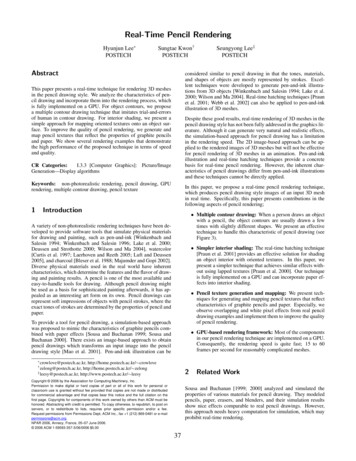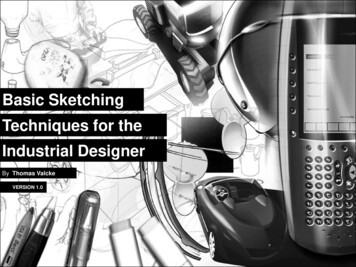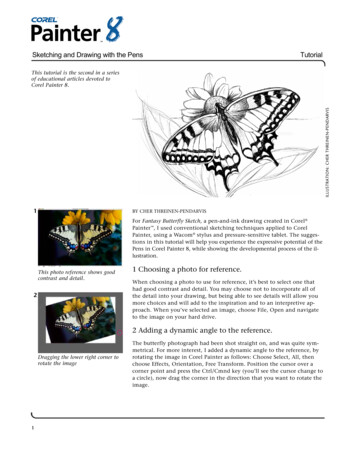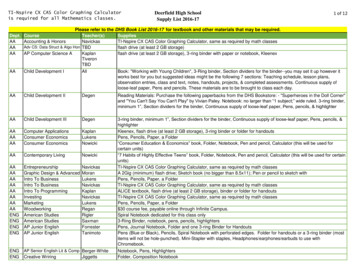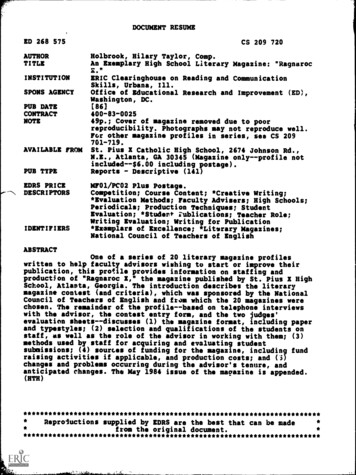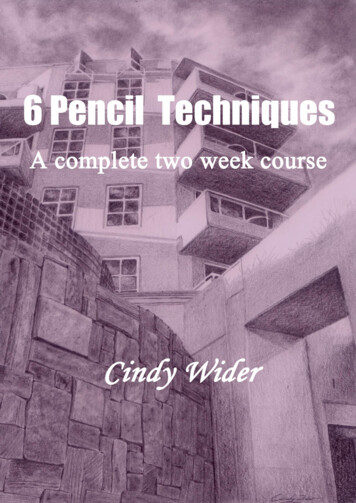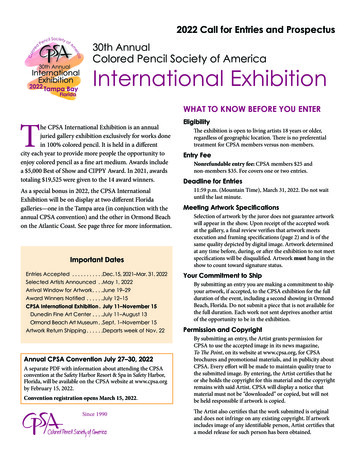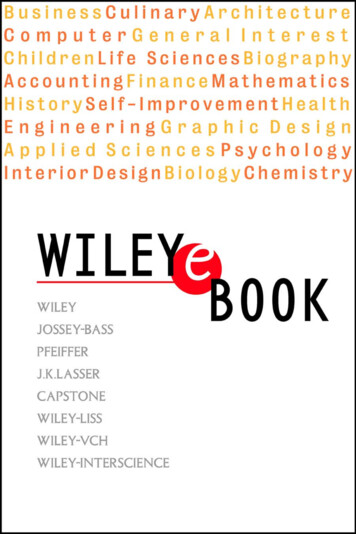
Transcription
*WANG FM(i-x)3rdpas6/25/0110:48 AMPage i(Black plate)PENCIL SKETCHINGSecond Edition
*WANG FM(i-x)3rdpas6/25/0110:48 AMPage ii(Black plate)
*WANG FM(i-x)3rdpas6/25/0110:48 AMPage iii(Black plate)PENCIL SKETCHINGSecond EditionThomas C. WangJohn Wiley & Sons, Inc.
fcopyebk.qxd8/21/019:43 PMPage iv(Black plate)Copyright 2002 by John Wiley & Sons, Inc., New York. All rights reserved.No part of this publication may be reproduced, stored in a retrieval system or transmitted in anyform or by any means, electronic, mechanical, photocopying, recording, scanning or otherwise,except as permitted under Sections 107 or 108 of the 1976 United States Copyright Act, withouteither the prior written permission of the Publisher, or authorization through payment of theappropriate per-copy fee to the Copyright Clearance Center, 222 Rosewood Drive, Danvers, MA01923, (978) 750-8400, fax (978) 750-4744. Requests to the Publisher for permission should beaddressed to the Permissions Department, John Wiley & Sons, Inc., 605 Third Avenue, New York,NY 10158-0012, (212) 850-6011, fax (212) 850-6008, E-mail: PERMREQ @ WILEY.COM.This publication is designed to provide accurate and authoritative information in regard to thesubject matter covered. It is sold with the understanding that the publisher is not engaged inrendering professional services. If professional advice or other expert assistance is required, theservices of a competent professional person should be sought.This title is also available in print as ISBN 0-471-39919-1. Some content that may appear in theprint version of this book may not be available in the electronic edition.For more information about Wiley products, visit our web site at www.Wiley.com
*WANG FM(i-x)3rdpas6/25/0110:48 AMPage v(Black plate)to my wife Jacqueline and my sons Joseph, Andrew, and Matthew
*WANG FM(i-x)3rdpas6/25/0110:48 AMPage vi(Black plate)
*WANG FM(i-x)3rdpas6/25/014:58 PMPage vii(Black plate)CONTENTSPREFACEIX1. I NTRODUCTION . . . . . . . . . . . . . . . . . . .12. MATERIALSPencils 7Papers 13AccessoriesANDEQUIPMENT . . . . . . . . . . 7173. TECHNIQUES . . . . . . . . . . . . . . . . . . . 19Holding the Pencil 19Pressure 23Movement of the HandLines and Strokes 315. COMPOSITION . . . . . . . . . . . . . . . . . . . 716. SKETCHING274. S KETCHING . . . . . . . . . . . . . . . . . . . 37Introduction 37Observation and RecordingLandscape Sketching 41Trees 43Trees in the Foreground 51Trees in the Background 52Landforms 55Water 59Architecture 63Sketching the Cityscape 6739FROMMEMORY . . . . . . . . . 857. EXAMPLES . . . . . . . . . . . . . . . . . . . . 91I NDEX . . . . . . . . . . . . . . . . . . . . . . . . 1 1 3vii
*WANG FM(i-x)3rdpas6/25/0110:48 AMPage viii(Black plate)Veniceviii
*WANG FM(i-x)3rdpas6/25/014:55 PMPage ix(Black plate)PREFACEThe purpose of revising Pencil Sketching is to update the content andto make it more suitable to the needs of today’s users. Although thepedagogical intent established 20 years ago remains valid and intact,most of the examples were in my opinion outdated. There are alsotechniques I learned after over 25 years of teaching and practicethat I want to incorporate in the new publication. Since the purposeof this book is to teach pencil sketching, I believe that a new book,with all new writings and illustrations, will serve the purpose well.Sketching with color pencil is intentionally left out because I feelstrongly that the basics in learning how to sketch and draw muststart with a simple black and white medium. Pencil is very specialbecause the traditional sketching techniques often go way beyond thetool itself and into the mind and body of the artist. To me, this is theonly way to learn and to master pencil sketching. Pencil sketching isthe door to all other drawing media, and good pencil sketching skills laythe foundation for a good artist. There are many great “technicians”who can draw, but what I really want is to make you an “artist.” I hopethis book will continue to be a helpful guide to all future artists.ix
*WANG FM(i-x)3rdpas6/25/0110:48 AMPage x(Black plate)
WANG CH1(1-6)3rdpas7/16/011:10 PMPage 1(Black plate)INTRODUCTIONPencil: The Medium1Pencil is special. Pencil is versatile. There is not a single drawingmedium that can perform so many tasks as a pencil. Because itcan produce lines of different widths, the same pencil can beused for shading, texture making, and emulating a wide range oftonal differences.To some, a pencil is no different from a pen or a marker becausethey can all be used for sketching. This kind of thinking ignoresthe fact that the look of pencil is unique and cannot be duplicated.The ability to visually understand and appreciate the differencesis essential. The intention of this book is to clarify the differencesbetween pencil and other sketching media. Many publications onpencil sketching and drawing never venture to the heart of thingsand discuss in detail the unique characteristic of pencil. They allspeak rather briefly about the medium and move quickly into techniques and demonstrations. Very few spend time talking about the“art of pencil sketching.”#2 pencilTo me, the real understanding of pencil sketching goes beyondknowing the “state-of-the-art” pencils and accessories. It is aboutcreative seeing, such as how to isolate things from a complex visualfield. It is about emotions and feelings and the communicationbetween artist and object. I believe that the in-depth discussionof the fundamentals is what will set this book apart from othersimilar publications.1
WANG CH1(1-6)3rdpas6/25/0111:26 AMPage 2(Black plate)Windtower in Bahrain; 314 pencil2
WANG CH1(1-6)3rdpas6/25/0111:26 AMPage 3(Black plate)Why Sketching?The trends of drawing in the last decade have includedconcerns about colors, styles, expression, and speed.These features are responses to new technology and ourcontemporary lifestyle. Yet these trends have little to dowith the pedagogy of design education and drawing. I seesketching as the foundation of a strong design curriculumand a prerequisite course for all future designers.Sketching is about eye–hand coordination. We see,observe, and then record. Pencil becomes the mediumthrough which images are transferred and documented.Pencil becomes the physical link between the eyes, themind, and the hand. It happens to be the ideal sketchingtool because it is easy to pick up and inexpensive to cultivate as a hobby. The flexibility and fluidity of pencilsketching is again another unique feature ideal for beginners. Knowledge and skills learned from pencil sketchingare easily transferable to other design subjects, and thebenefits are immeasurable and permanent.Sketching field notes on the back of printed material.It demonstrates the ease and simplicity of sketching.3
WANG CH1(1-6)3rdpas6/25/0111:26 AMPage 4(Black plate)Ninomiya Harbor in Japan; ebony pencil, emphasizing contrast4
WANG CH1(1-6)3rdpas6/25/0111:26 AMPage 5(Black plate)Sagami Bay in Japan; ebony pencil, emphasizing dark value5
WANG CH1(1-6)3rdpas6/25/0111:26 AMPage 6(Black plate)Venice, Italy; 2B pencil6
WANG CH2(7-18)3rdpas6/26/019:54 AMPage 7(Black plate)MATERIALSANDEQUIPMENTPencils2I always recommend that beginners start with the lowlynumber 2 yellow pencil. Number 2 is equivalent to HBgrade in terms of the hardness of the lead. Its markingsare medium in darkness and the lead has a moderatewear, which means that it doesn’t need frequent sharpening. It handles well and has a friendly touch. It’s a perfect pencil for a beginner.Different types of sketching pencilsThere are many types of pencils that do more or lessthe same task. The key is to find the few that you arecomfortable with. An ordinary pencil comes in differentgrades from high Bs to high Hs. Harder pencils havethe H markings and softer pencils bear B markings.Hard pencils are used primarily for drafting and technicalpurposes because the hard lead can maintain a very thin,sharp, and consistent line. It was very popular amongarchitects before the age of computers because smalland tidy lettering was required to accompany the carefully prepared architectural drawings. However, thesehigh-H pencils are not suitable for normal sketching anddrawing purposes. But soft pencil is ideal. Softer leadscreate darker values and they glide more easily onpaper. Yet, because the point of the lead will wear awayquickly, the lines from a soft pencil will inevitablybecome wider and less consistent.7
WANG CH2(7-18)3rdpas6/25/0112:10 PMPage 8(Black plate)TYPICAL PENCIL VARIETIESmedium 2 or HBsoft 3 Bextra soft 6 B8TYPICAL LEAD HOLDERS the top holder holds 1 4" diametersoft lead the other two are mechanicallead holders for drafting only
WANG CH2(7-18)3rdpas7/16/011:14 PMPage 9(Black plate)Mechanically sharpened 314 pencilChisel point after repeated useThere are also charcoal pencils, layout pencils, flat sketching pencils,ebony pencils, etc. Charcoal pencil has a charcoal core and it works justlike regular charcoal stick except for the fact that the tip can be sharpened like a pencil. Because it is encased in wood, it is a lot cleaner touse. I like the flat sketching pencil because it contains a square or rectangular lead that becomes a flat chisel when sharpened. It produceswide, broad strokes with many dynamic variations when twisted andturned. One of my favorites is the classic “draughting” pencil commonlyknown as 314. It has a rounded, dark brown wood casing with the lead noless than 1 8" in diameter. Because of the large lead, the exposed tip ofthe 314 is about half an inch long after sharpening. The long tip is valuable in sketching because it can do so many things from making a thinline to a broad half-inch stroke by holding the pencil on its side. It hasdark values and the tone is very intense.Rectangular pencil314 draughting pencil9
WANG CH2(7-18)3rdpas6/25/0112:10 PMPage 10(Black plate)Five major pencilsand the differencesin line quality.Mars Lumograph H2/HB (regular pencil)314 (draughting pencil)Ebony pencilCharcoal10
WANG CH2(7-18)3rdpas6/25/0112:11 PMPage 11(Black plate)PressureLightHardMars Lumograph H2/HB (regular pencil)314 (draughting pencil)Ebony pencilPrang charcoal11
WANG CH2(7-18)3rdpas6/25/0112:11 PMPage 12(Black plate)Quick sketch using 314 pencil on sketching vellum. The soft pencil and the fine tooth of the vellum surface areperfect partners in sketching . (Portofino, Italy)12
WANG CH2(7-18)3rdpas6/25/0112:11 PMPage 13(Black plate)PapersSketching on paper: the hand can rest comfortably on the table.Sketching on sketch book: the hand glides along the edge— not a comfortable position to get used to for beginners.Pencil sketching can be done on just about any kind of surface fromdinner napkins to fancy, smooth bristol board. For beginners, the mostimportant thing to remember is to use the least expensive whitepaper. I always recommend starting with a plain 81 2" x 11" white sheet.The advantage is not just because of the cost but because you canwork with one sheet at a time. It is a lot harder to learn sketching ona tablet or sketchbook if you have never done so. The thickness ofthe tablets and their edges can be a major hindrance to hand movement. This situation is definitely not the best way to build confidencewith your pencil. A single, flat sheet allows the beginning artist torest the palm of the hand comfortably on the drawing surface. Thetable also serves as a security anchor and allows for better balancingof the hand and prevents shaking. If one side is full, you can turn thepaper over and work on the other side. (But try doing this on athick sketching tablet: working on the back side of each page can bejust as hard as sketching on the right side.) Use these inexpensivepapers for shading practices or other loosening-up exercises. Onceyou gain enough confidence and control with your hand, you can thenmove on to something more fancy.Good sketching paper comes in many weights and textures. Weightrefers to the heaviness (i.e., thickness) of the paper. A 110-lb.paper is heavier or thicker than a 40-lb. paper. Normal drawing paperis between 50 to 110 lbs. Texture refers to the degree of grain ofthe drawing surface but, unfortunately, there is no numerical standard for the differences. The standard practice is to identify themby their names. Watercolor paper is rough and very grainy whileplate bristol is smooth and shiny. There are many commercial brandsof paper makers and you should choose by your sketching intents13
WANG CH2(7-18)3rdpas6/25/01LIGHT12:11 PMDARKPage 14(Black nypencil3142/HBMarsLumographHShading and lines on illustration paper(smooth/glossy stock). Notice the lackof variation in value and line quality.14Shading and lines on regular copy paper.Shading and lines on watercolor paper.
WANG CH2(7-18)3rdpas7/16/011:15 PMLIGHTPage 15DARK(Black plate)LINESand by how much you can afford. Remain neutral on the issue ofcotton fibers versus wood pulp and the whole business of recycledpaper, as the differences between them will not affect the outcomeof your sketch.My own definition of a good sketching paper is one that has a moderate degree of roughness: its surface should have a little bit of“grain” or “tooth” that can grab and hold onto the lead. The surfaceof a very smooth illustration board, however, is not recommended forgeneral sketching. It is too smooth and is therefore given to deepgrooves or indentations from the pencil markings which makes it difficult to draw back over them. Although some argue that a smoothsurface is better for building up textures, I do not think it is idealfor beginners.CharcoalEbonypencil314On the other hand, cold-press watercolor paper has a very roughsurface and can easily wear out a typical pencil point. It is so roughthat the pencil has a very hard time navigating it. A beginner willhave trouble controlling the line quality and making a decent sketch.A well-intended straight line often turns out broken and the shadedarea becomes laced with small white dots. Rough paper is very difficult to master and is only recommended for advanced artists who arelooking for a certain kind of effect.2/HBMarsLumographHShading and lines on sketching vellumMy favorite paper is the plain sketching or drawing paper in moderate weight (around 80 lbs.). It often comes in several sizes, fromsmall sketching pads to large easel-size sketch tablets. I oftencarry a small 81 2" x 5" sketch book with me for quick visual recording on the run. This is a habit that I developed in my early collegedays and it has proven to be a most useful practice for someonewho loves to draw.15
WANG CH2(7-18)3rdpas6/25/0112:11 PMPage 16(Black plate)Quick sketch (Serena Inn, Zanzibar, Tanzania; 314 pencil on watercolor paper)16
WANG CH2(7-18)3rdpas6/25/0112:11 PMPage 17(Black plate)AccessoriesYou can sharpen your pencil with a small pocketknife if you don’t have an electric pencil sharpener,but I prefer the latter because it tends to producea longer exposed tip, which is good for the veryreasons discussed in the first section of this chapter. A longer tip also prolongs the life of thesharpened lead and thus maximizes the time intervals between each sharpening. Sanding boards,emory pads, and sandpaper are all improviseddevices to help keep the tip sharp. Use whateveryou prefer. Strike on a piece of rock or pavement ifyou don’t have any of the above.I am not a fan of erasers because I think they produce an attitude of dependency, and this is counterproductive to improvement. I prefer sketching overthe mistakes or building on them to create something new and non-static. In case you need one, useeither a kneaded eraser or a soft white plastic one.The soft rubber of the kneaded eraser simplyabsorbs and picks up the unwanted graphic markingswithout leaving crumbs on the drawings. The plasticwhite eraser can pick up a great deal of theresidue, but leaves crumbs that require sweeping.Neither eraser can erase cleanly. Each will mar thesketching surface and change the texture of thepaper. A smooth paper is very unforgiving and anyattempt to erase can easily lead to disaster.17
WANG CH2(7-18)3rdpas6/25/0112:11 PMPage 18(Black plate)LINE DRAWINGLINE AND TONE DRAWINGThe use of simple pencil lines to describethe object. Except in the areas under thearches where spacing between lines becomesvery close, the rest of the lines are independent, with clean and single pencil strokesclarifying the spatial edges of the tower.Shading is used to differentiate thelight and shaded planes. Short and continuous pencil strokes are used to givea suggestion of shadows; this techniquetends to reinforce the three-dimensionalquality of the tower.18LINE AND TONE DRAWING DONE WITH314 PENCILThe softness of the lead gives a bettervalue definition of the black. It also simplifiesthe shading process because you can actuallyuse fewer strokes to cover the same areathan when you use a traditional No. 2 pencil.
WANG CH3(19-36)3rdpas6/26/0111:31 AMPage 19(Black plate)TECHNIQUES3Holding the PencilControl the pencil with three fingers.The grip should be relaxed but firm. Control themovement with the same three fingers.There are many ways to hold the pencil but thekey word to remember when sketching is “relax.”Avoid holding the pencil as if you were writingbecause the writing grip is rather firm and tight.The sketching grip is comparatively looser andeasier. Hold the pencil approximately two to threeinches from the tip of the lead. The grip positionshould involve the thumb and the first two fingersonly, with the pencil resting comfortably on theinside of the tip of the third finger. Use the second finger and the thumb to stabilize the penciland to prevent it from slipping out.The relationship between the second finger andthe thumb usually dictates the type of lines andsketching style. When the tips of the two arerelatively close together, anchoring the pencil,the entire hand generally folds inward; and thus themobility and reach of the pencil movement is limitedby how far the fingers can stretch. This position iscalled Position A and is quite similar to the writinggrip. It is very useful in sketching short strokes anddetails, and it gives the artist more control of thetool while it is less prone to making mistakes.19
WANG CH3(19-36)3rdpas6/26/0111:37 AMPage 20(Black plate)WRITING POSITION tight gripno flexibilityhold very close to leadSKETCHING POSITIONS looser grip flexible hold farther up the shaftPOSITION A20
WANG CH3(19-36)3rdpas7/16/011:27 PMPage 21(Black plate)POSITION BPosition B is when the tips of the second finger andthumb are far apart. The second and third fingers areusually straight instead of being curled inward, increasingthe mobility and reach of the pencil. By sweeping upand down with the extended second and third fingers,the strokes can reach six to seven inches. This is anideal position for shading because the grip is loose andthe fingers are much easier to move. This position alsoallows the artist to hold the pencil sideways and maximizes the effectiveness of the entire pencil tip. Broadstrokes are one result of this grip. Simply extend thefingers of the entire hand with the palm down and glidethe pencil across the page. The angle of the pencil mustbe adjusted to the individual artist’s hand and degree offlexibility. One should be able to switch from Position Ato Position B in a continuous movement without hesitation or stoppage.The third position (Position C) involves holding the pencilas if holding a putty knife or small hand tool. The pencil isheld between the thumb and the second finger. Thiseliminates any form of finger or hand movement and istherefore mainly suited for long and broad strokes. Theentire forearm is used, giving the artist maximum reach.Depending on the size of paper available and the reach ofthe artist’s arm, pencil strokes can reach over threefeet. This position can also be used to create chiselstrokes. Just hold the pencil and strike it up and downusing short and abrupt strokes.POSITION C21
WANG CH3(19-36)3rdpas6/26/019:41 AMPage 22(Black plate)Perfect example of sketching inPosition A. Focusing on architecturaldetails requires a tight grip of thepencil (for better control). Down/upand lateral movement is minimal.Mars Lumograph H pencil was chosenfor the hard lead.Lower Manhattan, New York; H pencil22
WANG CH3(19-36)3rdpas7/16/011:44 PMPage 23(Black plate)PressureApplying pressure (force) to the pencil is what gives grace and liveliness to a line. Without pressure, the strokes and lines are plain and boring. A simple line drawing in pen and ink can be quite beautiful when thereis a consistency in the lines, as this kind of uniformity can bring out theclarity and lightness of the sketch. A pencil is not a pen, however, and apencil line should not strive for consistency. A hard lead can provide a linethat is relatively consistent when compared with a softer lead. But thebeauty of pencil sketching lies in the artist’s ability to apply pressure tothe pencil in order to alter the quality of the lines. The striking, liftingand rotating, the occasional nudging and twisting, and the sudden changeof the angle of the lead all contribute to a multitude of effects whichare unique to pencil sketching. And it is this uniqueness that makespencil special.Simple lines with no pressure applied to the pencil;associated mostly with hard pencil.Lines which show signs of pressure and the twist andturn of the pencil; the trademark of using a soft pencil.A pencil should and must be treated as an extension of the artist’s hand,arm, and fingers. After all, it is only through this kind of intimate joining thata sketch can be produced. The mechanics of sketching involve not just themotion of a hand holding a pencil, but the entire sensory relay from eyes tobrain to hand, and so forth. We observe and examine with our eyes; simplifywith our brain and eyes; reason with our brain about what should be kept;record with our hand; evaluate with our eyes again to see if the image looksat all like the one we saw earlier; make instant changes and reevaluateeverything again in a perpetual cycle. This is the sketching process in anutshell. And just as sketching is undoubtedly a mental process that isvery personal and intimate, so too is the act of applying pressure to thepencil a personal and intimate experience. There is no scientific standard forhow much force one should exert on a certain lead. It is basically a trialand-error process because you learn from your mistakes and successes.You do it repeatedly to achieve a consistent pattern and you try to keep itthat way, but no one can teach you how to do it. Finding the right force23
WANG CH3(19-36)3rdpas6/25/011:18 PMPage 24(Black plate)STROKE AND PRESSUREMars Lumograph H2/HB314Ebony pencilCharcoalBegin lightly24Increase pressurePress hard
WANG CH3(19-36)3rdpas6/25/011:18 PMPage 25(Black plate)and knowing how hard to press the lead is something which novicesdream about. It takes time and devotion, and there are certainly noshortcuts on this journey of learning and experiencing. . . Time to return from getting too philosophical and Zen-like. Thereare actually a few tricks one can learn in the exploration of pressureand force. The key here lies in the grip. Since pressure emanatesfrom the fingertips, the grip and the contact between the fingersand pencils are extremely crucial. For example, using the Position Bgrip, when the thumb is the only finger that exerts the force, thethird finger becomes the receiving side and must offer some form ofresistance. This knowledge can be taught and learned. The amount ofresistance is the key in determining the value of the shading. Adarker value is due to less resistance and vice versa. To alter andvary the value of the pencil shading depends entirely on the artist’sability to press and lift at the appropriate moment. Unlike learninghow to hold the pencil, this is not something that can be quicklytaught, but it must be practiced over time.I hope this helps to clarify what I said earlier about the personaland intimate experience of sketching. Yes, pencil is the easiestsketching practice to learn. But it is nevertheless a very hardpractice to master because of the nature of the material. Still,this should not keep you away from learning how to sketch with apencil. On the contrary, I hope that this quality will attract you tothe medium.314 pencil25
WANG CH3(19-36)3rdpas6/25/011:18 PMPage 26(Black plate)Abbey of San Fruttuoso, Italy26
WANG CH3(19-36)3rdpas6/26/0111:39 AMPage 27(Black plate)POSITION AMovement of the HandUp/down strokesDiagonal strokesMinimum finger movementIn essence, movement of the hand refersspecifically to the act of sketching. Thethree grip positions described in the previous chapter correlate directly to thethree different kinds of movement.Finger movement (Position A)Normal finger movementUp and down movement of Position AMaximum finger movement (notice slightarc in strokes)Because the grip is relatively tight inthis position, movement is limited to justthe fingers. Lines and strokes can bedrawn by the gentle motion of pushingand pulling the pencil with the thumb andthe second and third fingers. Verticalstrokes can be easily drawn by movingthe fingers up and down while plantingthe hand steadily on the drawing surface.Horizontal strokes, however, require fixingthe finger grip while moving the wristfrom left to right and keeping the handloose at the same time. By turning thehand slightly to the side, you canincrease the reach. This gives the artistmore freedom to move the pencil and theability to create longer strokes. The shiftin the grip and angle signals the gradualchange from Position A to B.27
WANG CH3(19-36)3rdpas6/26/0111:40 AMPage 28(Black plate)POSITION BHand movement (Position B)The grip in Position B is slightly higher and gives the artist thegreatest flexibility to draw a wide range of strokes and lines.By moving the hand, the strokes can cover a larger area. Thefingers must be locked in a fixed position, allowing the entirehand to move freely, pivoting from the wrist. The center of thewrist in this kind of movement becomes the center while thehand becomes the radius. Strokes therefore tend to appear asan arc but the effect can be modified by extending the arm.Strokes tend to be more diagonal;consistently adjust the position ofthe hand to change the directionof strokes; notice the strokestend to get wider because of theangle at which the lead strikesthe paper.Up and down movement of position B. (Note thelonger reach and slight arc.)28
WANG CH3(19-36)3rdpas6/25/011:18 PMPage 29(Black plate)POSITION CArm movement (Position C and others)Sketching goes “big time” when the arm begins to getinvolved. It’s also when you need to move beyond the small 81 2"by 11" sketch pad and onto something bigger. By changing thegrip and by moving and extending the entire arm, an artist cancreate long, sweeping strokes that fly across the page (orwall, if necessary). Large format sketching must be accompanied by a proper sketching medium, such as a large pencil withsoft lead. Charcoal stick is also a very appropriate medium touse. This kind of movement is very suitable for expressinglandscape scenery on a grand scale.Left to right movement of Position CTaking advantage of the low angle ofthe pencil and using the entire side ofthe exposed lead to strike the paper;an ideal position for broad strokes.29
WANG CH3(19-36)3rdpas6/25/011:18 PMPage 30(Black plate)LinesStrokesStrokesLines30
WANG CH3(19-36)3rdpas6/25/011:18 PMPage 31(Black plate)Lines and StrokesSimple lineLine refers to a long and continuous thread with aconsistent width, while strokes are comparativelyshort and broken lines in a variety of widths. Lineis the residual mark left on the paper as a resultof a pencil gliding across it. It is graceful and fluidin nature. Strokes, on the other hand, are strikemarks and they are often bold and deliberate.Short strokesLong strokesContinuing strokesIn sketching, line is used to define spatial edgesand describe objects. A variety of widths can beachieved by simply adjusting the angle of the lead.In theory, a hard lead produces a thin and lightline, while a soft lead produces a dark and thickline. However, a good quality, soft sketching pencilis equally capable of producing a wide range oflines by itself. It is quite unnecessary to stockyourself with an array of leads because one ortwo simple pencils will do all the tricks.In sketching, it is always a good idea to try touse a variety of line widths to avoid a monotonouslook. For example, a profile line (a thicker linewidth) is used to visually lift the object from thebackground and to make the object look morethree-dimensional. Different line widths within asketch give the sketch a better sense of depthand space. This is especially evident when sketching landscape.31
WANG CH3(19-36)3rdpas6/25/011:18 PMPage 32(Black plate)BASIC TEXTURESShort individual strokes; changedirection occasionally to createa cross-hatching effect.AShort, continuous strokes; changedirection occasionally.BContinuous M-strokes; changedirection constantly.CContinuous W-strokes; changedirection constantly.DVery short M-strokes withconstant direction.E32
WANG CH3(19-36)3rdpas6/25/011:18 PMPage 33(Black plate)Begin with small finger movement; increase pressureon pencil; expand movement to include moving of thehand; use the wrist.PRACTICE STROKES (A)2/HB pencilFocus primarily on finger movement; adjust angle ofhand accordingly.PRACTICE STROKES (B)2/HB pencilShort up/down strokes using finger movement;glide the hand across the page to repeat stroke;rotate pencil.PRACTICE STROKES (C)314 pencilRotate pencil to get a sharp point33
WANG CH3(19-36)3rdpas6/25/011:18 PMPage 34(Black plate)Bandstand in Zanzi
the fact that the look of pencil is unique and cannot be duplicated. The ability to visually understand and appreciate the differences is essential. The intention of this book is to clarify the differences between pencil and other sketching media. Many publications on pencil sketching and

